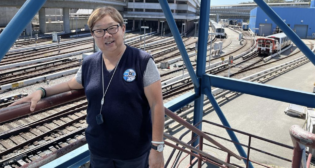
From AAR, a ‘Clarifying Perspective’ on Safety
Written by William C. Vantuono, Editor-in-ChiefRegarding to Surface Transportation Board docket Urgent Issues in Freight Rail Service, EP 770; Urgent Issues in Freight Rail Service—Railroad Reporting, EP 770-1, some rail labor unions have been providing STB (as well as general media outlets) with what the Association of American Railroads is characterizing as a misleading, “distorted picture” with incomplete information requiring clarification. AAR Counsel J. Frederick Miller Jr. on July 7 wrote to the STB regarding this matter. Following is the full text:
“In light of several recent communications from organized labor regarding the industry’s safety and employment record, which have been filed in this service issues docket, the Association of American Railroads (AAR), on behalf of the Class I freight railroads, would like to provide some clarifying perspective. The Board opened this proceeding over concerns with rail service, and railroads know that safe, well-compensated and appreciated employees are key to the service improvements that the industry has made over the past year. Accordingly, it is important that the Board has a complete picture of the current state of railroad safety efforts.
“The Railroad Workforce is Increasing and Employee Relations Are Improving: The pandemic, followed by the quick bounce-back of the economy, turned all labor markets upside down. When rail traffic collapsed during the pandemic, railroads deployed the long-standing approach of temporarily furloughing employees. As the economy recovered, railroads discovered that far fewer furloughed employees chose to return than historical patterns would suggest. This led to workforce shortages that impacted service.
“Progress is being made. Rail employment is growing. In May 2023, total Class I freight railroad employment was up 6,620 employees over May 2022 and is at its highest level since April 2020. Train and engine (T&E) employment for May 2023 was 52,043, which is up 8,383 employees from May 2020, and surpassed pre-pandemic levels of 51,709 in January 2020. The month of May 2023 saw the 16th straight month in which total T&E employment grew. May 2023 also saw some of the highest levels of employment for maintenance of way (28,909 employees) and maintenance of equipment (18,267 employees) since the pandemic began. While more hiring needs to and will be done, railroads are confident they will continue successfully recruiting the next generation of railroad workers to meet the nation’s rail freight demand.
“Railroads also are making real progress in improving their relationships with their employees and improving employee quality of life. Since the execution of the most recent collectively bargained agreements, every Class I railroad has announced further agreements with many of their unions—41 in total—on quality-of-life issues, such as more predictable work schedules and additional paid sick leave. One such agreement regarding work schedules was described as “life altering” by the labor leader who negotiated it. Through these agreements, 63% of all craft employees now have up to seven paid sick leave days in addition to the substantial pre-existing paid leave days and short- and long-term paid sickness benefits already in effect across the industry. The attached chart provides more detail on these agreements. Railroads are proud of this progress, and strongly believe these efforts will help spur additional employment growth.

“The Past Decade Has Been the Safest on Record: According to data from the Federal Railroad Administration (FRA) and contrary to organized labor’s claims, the past decade has been the safest in railroad history. In fact, in 2022 the industry set new safety records, while coming close to breaking others. Specifically, 2022 was the safest year ever for incidents involving hazardous materials. The hazardous materials accident rate (per thousand hazardous materials carloads) is down 76% from 2000. The overall train accident rate (measured per million train miles) for freight and passenger railroads was 26% lower in 2022 than in 2000, with the accident rate for trains traveling on railroad main lines—that is, outside of rail yards—was 43% lower in 2022 than in 2000. Some cite the figure of 1,000 derailments per year, because it sounds alarming. What is left unexplained, however, is that 76% of those derailments are in rail yards, not on the main rail lines that carry freight around the country. See FRA, Train Accident by Railroad Groups. For Class I freight railroads, the main line accident rate in 2022 has been reduced 48% from 2000, and was the second lowest of all time.
“Pursuant to FRA regulations, there are three categories of reportable incidents: (1) highway-rail grade crossing incidents; (2) rail equipment incidents that cause damage above the reporting threshold ($11,500 in 2023); (3) or incidents resulting in a death or significant injury. 49 CFR § 225.19. A point of clarification: FRA and AAR’s accident rate numbers exclude highway-rail grade crossing incidents. This avoids double counting crossing collisions that meet the accident reporting threshold when crossing collisions and accidents are combined, and also makes sense given such incidents are overwhelmingly caused by factors outside of the railroads’ control. The labor organizations not only include highway-rail grade crossing incidents, but also non-reportable incidents, to inflate their ‘derailment’ numbers (which is a misnomer as these incidents do not necessarily involve ‘derailments’) to claim that the numbers of ‘derailments’ have increased over the past ten years. Including these categories of incidents presents a distorted picture of railroads’ safety performance.
“Likewise, from 2000 through 2022, the employee injury rate was down 48%, and for Class I railroads, the decline was 62%—a new record low. According to data from the Department of Labor, railroads have lower employee injury rates than most other major industries, including trucking, airlines, agriculture, mining, manufacturing, and construction—even lower than grocery stores. Railroad employees’ strong safety culture, paired with the industry’s sustained investments in the network and in safety-enhancing technology have delivered meaningful results, and will continue to do so as we continue to drive toward zero.
“Again, the Board opened this docket out of concerns over rail service, and the industry knows that our employees are critical to providing safe and efficient service. As a direct result of the industry’s employment efforts service performance is trending positive, and the railroads expect to experience continued improvement.”



